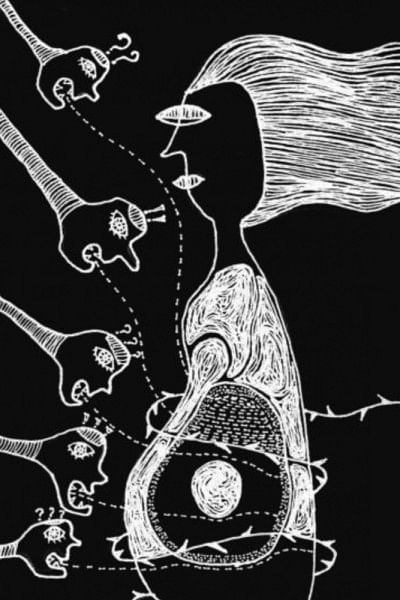Reproductive coercion or business as usual?

Maleka (not her real name) found herself in a whirlwind relationship in which she felt she has no control. She got pregnant because she couldn't negotiate condom use with her partner and then her partner blamed her for it, even though they both had a role in it. Obviously. Her pregnancy was questioned, she was accused of getting pregnant to serve her own needs, and then left alone to fend for herself under the pretext of a misunderstanding. He did not respond to her calls for help when she needed him. She dealt with the emotional trauma of a pregnancy she had to terminate by herself, feeling that the pregnancy or its termination should not have been her burden to bear alone.
Saleka (also not her real name) is pregnant for the fifth time. Inheritances notwithstanding, she works, as does her husband—which means they are of means. They can afford to have five children, send them to day care and private school, maintain an education fund in each of their children's names. But, she looks tired all the time. When asked about it, she sighs and says she's happy, more to herself than to anyone else, I feel. She posts happy photos on social media, but she no longer has time to hide the dark circles under the eyes. They've become permanent fixtures on her face. There was a time when she used to care about those things; she no longer does. She had once said, he wants more children. Just once. But that was enough.
A 10-year-old rape victim in India was disallowed from having an abortion by India's Supreme Court. She had the baby on August 28. She was not told about her pregnancy. Unbeknownst to her, a C-section was performed to birth the child.
The stories of Saleka, Maleka, and the 10-year-old girl lie on the spectrum of reproductive coercion by intimate partners, social norms, expectations, and the State. In the case of Saleka, the coercion was, and still is, more subtle, perhaps emotionally manipulative; even though, she would never even call it coercion. In the case of the 10-year-old, the coercion was public, authoritative, final, and importantly, hidden from her. In the case of Maleka, the coercion (to undergo menstrual regulation) was part of a toxic, unhealthy relationship that she left after months and months of trying to fix it.
National data suggests that 80 percent of women in Bangladesh report being in unhealthy relationships in which they are abused by their husbands or intimate partners. We must realise, then, that it's just about everyone that is experiencing intimate partner violence (IPV). Or, that it's just about everyone who is inflicting violence on their partners. The literature on IPV shows that women who experience IPV are often subject to reproductive coercion, much like Maleka. Another body of research identifies that many women in abusive relationships often remain in them because they form unhealthy attachment and emotional dependency on their abusive partners, often by use of pull-push psychological tactics instigated by the abuser. Additionally, women are often cajoled into believing they can fix the relationships because "their" actions cause the turmoil in their relationships to begin with.
The good news, though, is that women who are in abusive relationships don't always lose control over their bodies, at least in Bangladesh. Maleka's story resonates with findings from a study Gretchen Ely and I conducted last year to find that women who experienced IPV were more likely to use contraceptives, perhaps to ensure that a child is not brought into the unhealthy mix.
That said, however, I must also say that Maleka is not representative of women who experience unwanted pregnancies in Bangladesh. Most women who get pregnant accidentally are unaware of the choices they have. When they find out that they are pregnant it is often too late for them to access legal abortion services, even if they do know about their choices. Finally, the myths that service providers bring to service delivery create misunderstandings and confusion about services that in turn result in uninformed decision-making.
Let me explain.
Abortion is illegal in Bangladesh unless the mother's life is at risk. All other concerns, including rape, are deemed unworthy of concern, which includes, obviously, the mental health ramifications of birthing your rapist's child.
Bangladesh has a caveat, like many other developing nations. Since 1979, Bangladesh's national family planning programme has allowed women to undergo a procedure called menstrual regulation (MR) up to 12 weeks after a woman's last menstrual period. Menstrual regulation through medication (mifepristone and misoprostol) can be done up to 9 weeks after a woman's last menstrual period.
Despite the wide availability of MR services, surgical abortion rates in Bangladesh are fairly high, especially when compared to MR rates. In 2014, the annual rate of MR was 10 per 1,000 women aged between 15 and 49 years, while the abortion rate was 29 per 1,000 women in the same age group, for a total of 1,194,000 induced abortions in 2014 (Guttmacher Institute, 2014). Needless to say, most of these abortions were conducted in clandestine clinics by untrained professionals.
The question is why.
The Guttmacher Institute provides some answers:
- Most women do not know about MR. According to the most recent Demographic and Health Survey from Bangladesh, more than half of the women in the survey had not heard of MR.
- Three in 10 public or private facilities do not have equipment, trained staff, or both, which has resulted in 105,000 women (27 percent of all women seeking MR) being refused MR services.
- Most facilities indicated that the primary reason for turning women away had to do with them being pregnant beyond the 12-week mark or other medical reasons. As in the case of the 10-year-old girl in India, legal abortion is impossible when the pregnancy is at a later stage.
- Facilities also cited social and cultural reasons for turning women away when they tried to access MR services. As indicated in a Guttmacher report, 27 percent were turned away "because they were childless," seven percent considered the women "too young," eight percent turned them away because they didn't have their husband's consent, and six percent for being unmarried.
Anecdotal evidence from my interviews with women about their reproductive health and contact with service providers suggest that indirect manipulation, including asking repeatedly if they were ready for an MR, asking if they were interested in knowing the gender of the fetus even though gender can only be determined after being pregnant for 10 weeks, invoking the father and issues of permission, scare tactics about risky future pregnancies, and other coercive tactics play a role in women changing their minds about undergoing MR. This highlights the role of providers in providing MR services, reminding us how little we know about what providers, particularly low-skilled technicians and nurses, know about procedures like MR, and how their perceptions impact the way in which they provide services to women seeking MR.
My sense of how MR is viewed in Bangladesh is that it is not stigmatised in the same way that abortion is in other parts of the world, such as the United States, and we should keep it that way.
However, the rise in the number of potentially clandestine (non-MR) abortions is alarming. The rise of the number of Salekas and Malekas and children who are raped is alarming. It speaks to a culture where women's bodies are readily expected to bear the brunt of relational and structural problems even when that puts their bodies in harm's way. It continues the legacy of placing patriarchal and ideological baggage on the shoulders of women.
Nadine Shaanta Murshid is Assistant Professor, School of Social Work, University at Buffalo, the State University of New York.





Comments